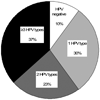Early natural history of incident, type-specific human papillomavirus infections in newly sexually active young women
- PMID: 21173170
- PMCID: PMC3078690
- DOI: 10.1158/1055-9965.EPI-10-1108
Early natural history of incident, type-specific human papillomavirus infections in newly sexually active young women
Abstract
Background: Characterizing short-term detection patterns of young women's incident α-genus human papillomavirus (HPV) infections may further our understanding of HPV transmission.
Methods: Between 2000 and 2007, we followed 18- to 22-year-old female university students with triannual HPV DNA and Papanicolaou testing. Using Kaplan-Meier methods, we estimated duration of detectable, type-specific incident infections; time to redetection (among infections that became undetectable); and time to cervical lesion development after incident infection. We evaluated risk factors for short-term persistent versus transient infection with logistic regression.
Results: Three hundred three incident, type-specific infections were detected in 85 sexually active women. Median time to first negative test after incident infection was 9.4 (95% CI: 7.8-11.2) months; 90.6% of infections became undetectable within 2 years. About 19.4% of infections that became undetectable were redetected within 1 year. Cervical lesions were common and 60% were positive for multiple HPV types in concurrent cervical swabs. Incident HPV detection in the cervix only (vs. the vulva/vagina only or both sites) was associated with short-term transience.
Conclusions: Although most incident infections became undetectable within 2 years, redetection was common. Cervical lesions were a common early manifestation of HPV infection.
Impact: It remains unclear whether potentially modifiable risk factors can be identified to reduce infection duration (and transmission likelihood).
Conflict of interest statement
None of the other authors have commercial or other associations that might pose a conflict of interest.
Figures





References
-
- Bosch FX, Burchell AN, Schiffman M, Giuliano AR, de Sanjose S, Bruni L, Tortolero-Luna G, Kjaer SK, Munoz N. Epidemiology and natural history of human papillomavirus infections and type-specific implications in cervical neoplasia. Vaccine. 2008;26 Suppl 10:K1–K16. - PubMed
-
- Sycuro LK, Xi LF, Hughes JP, Feng Q, Winer RL, Lee SK, O'Reilly S, Kiviat NB, Koutsky LA. Persistence of genital human papillomavirus infection in a long-term follow-up study of female university students. J Infect Dis. 2008;198:971–978. - PubMed
-
- Winer RL, Hughes JP, Feng Q, O'Reilly S, Kiviat NB, Holmes KK, Koutsky LA. Condom use and the risk of genital human papillomavirus infection in young women. N Engl J Med. 2006;354:2645–2654. - PubMed
-
- Baer A, Saroiu S, Koutsky LA. Obtaining sensitive data through the Web: an example of design and methods. Epidemiology. 2002;13:640–645. - PubMed
Publication types
MeSH terms
Grants and funding
LinkOut - more resources
Full Text Sources

